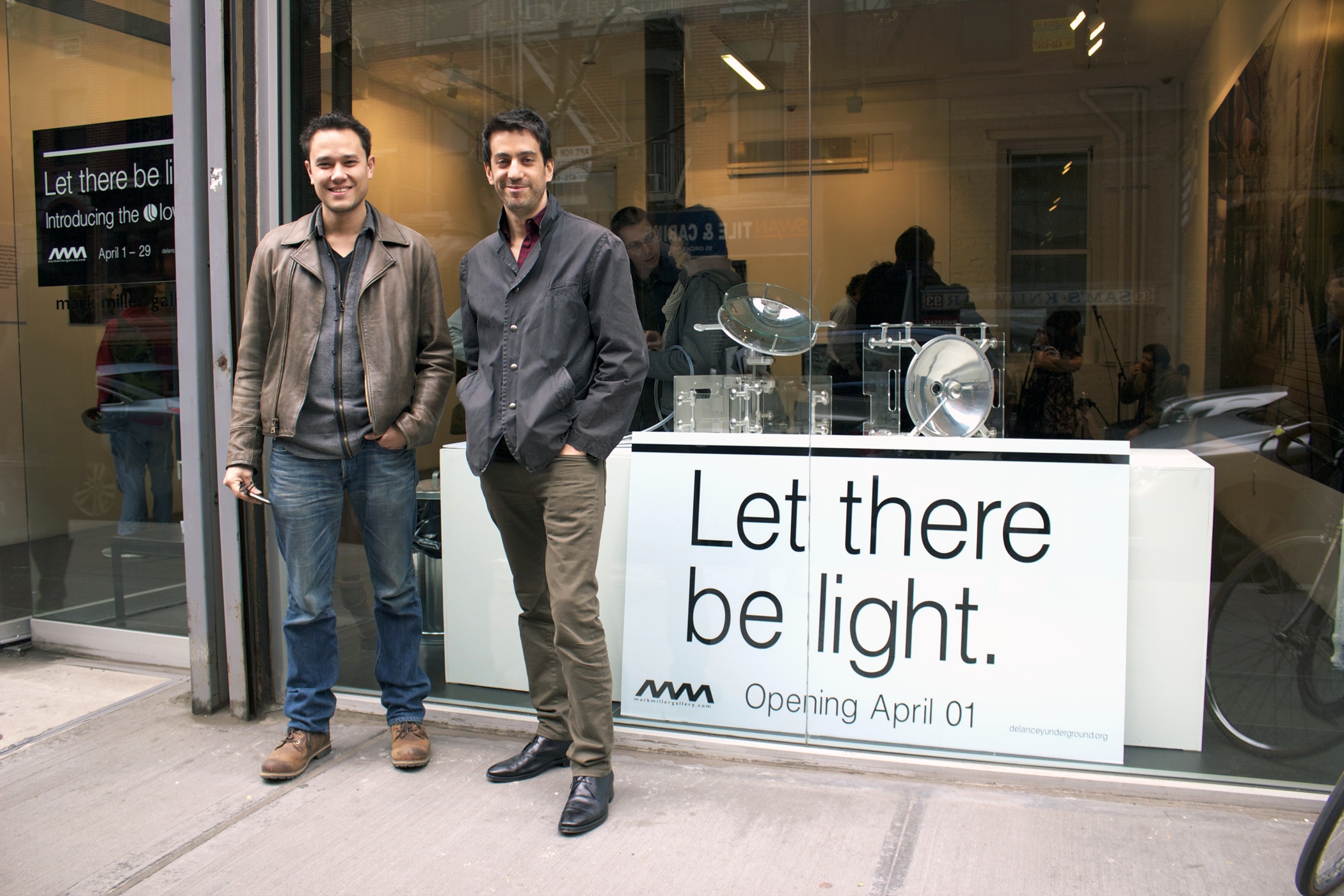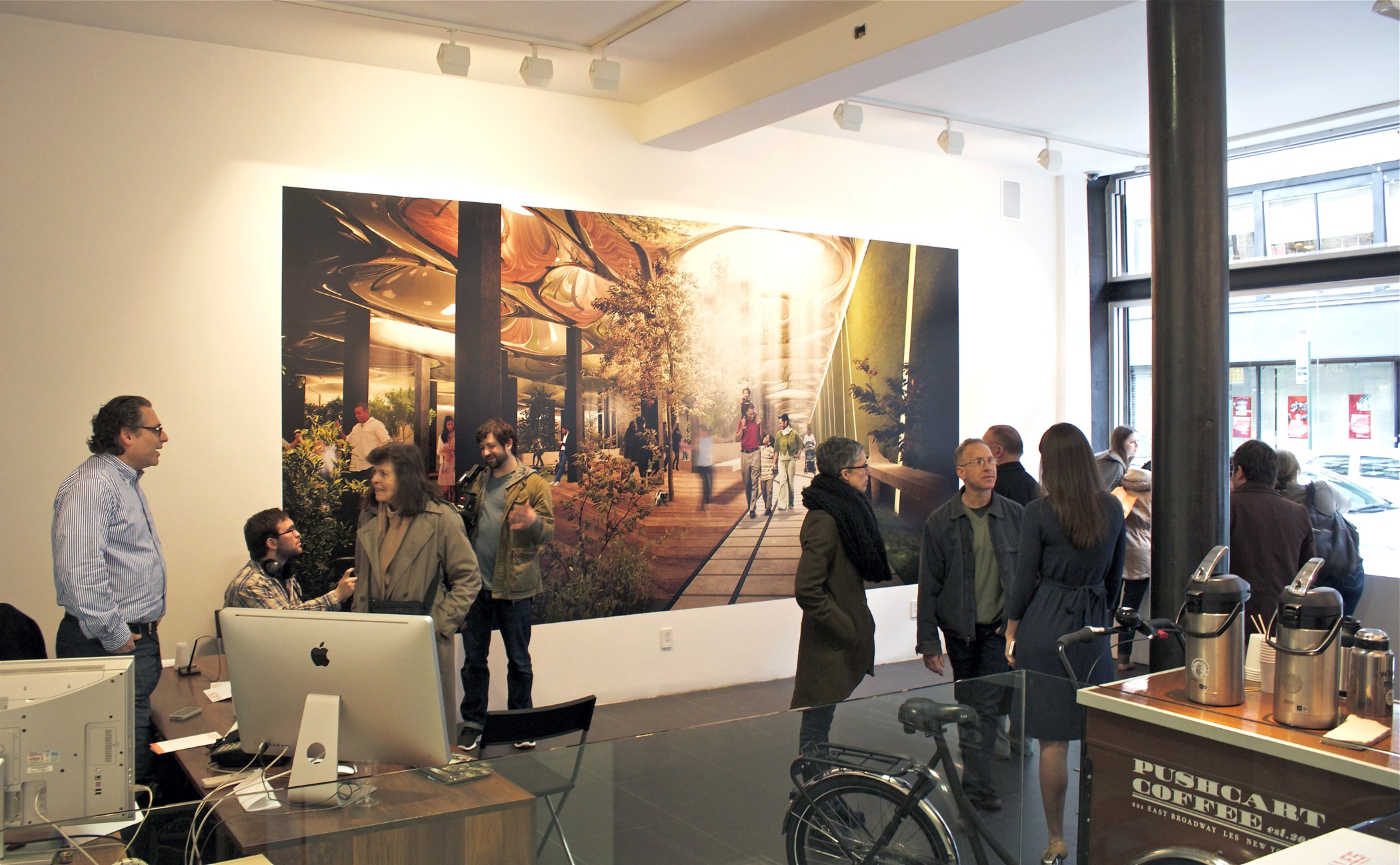When James Ramsey and Dan Barasch first toured the dark and filthy space beneath Delancey Street, with old cobblestones, crisscrossing rail tracks, and a vaulted ceiling obscured by grime and decay, they found a very specific image came to mind.

“It looked like the dwarf mines from ‘The Lord of the Rings’ movies,” said Ramsey, recounting the time when he and Barasch, co-founders of the LowLine project, first toured the space in March 2011.
But the duo are in the beginning stages of an effort to reclaim the space, a 60,000-square-foot abandoned trolley terminal, unused since 1948, under the heart of the Lower East Side.
They imagine an underground park, the first of its kind, that residents can go to all year round, even when it’s pouring rain or snowing.
Having raised more than $150,000, Ramsey and Barasch are refining their proposal to the MTA, owners of the terminal. They face an uphill struggle, but are determined to replicate the success of the High Line, which arose out of similar circumstances.
Ramsey is a former NASA engineer and the founder of RAAD Studio, an architectural design firm on the Lower East Side, while Barasch, who specializes in non-profit organization management, is the former vice president of PopTech, a yearly conference that supports technological innovators and entrepreneurs.
On April 1, Ramsey and Barasch held an open house for their “Let There Be Light” exhibit in the Mark Miller Gallery on the Lower East Side. The exhibition, which will run through April 29, showcases images, architectural renderings, and a model of Ramsey’s ‘remote skylight’ technology. On February 22, they launched a 45-day Kickstarter campaign to raise money for the project and, to their surprise, they reached their goal of $100,000 within a week. The money came flowing in from around the world, including donors in Japan, South Africa and Germany.
According to Barasch, the LowLine team needs the money to do three main things: conduct engineering studies, develop a feasibility model, and build a temporary technology demo to showcase the concept in real form.
Experts in the field of urban design have noticed a new trend in the last 20 years, where the architects and designers are looking to save and reuse old industrial spaces.
“The LowLine fits into the broader trend in urban development where the emphasis is on capitalizing existing pieces of infrastructure,” said Elihu Rubin, a professor at the Yale School of Architecture, who is listed as a supporter of the Low Line, in a phone interview with the Free Press. Rubin sees the High Line, the elevated railroad in Chelsea that was rediscovered and remade as a successful park and public space, as a kind of predecessor to the LowLine.
“There is an increased sensitivity to the history of the city,” said Rubin. According to him, people no longer see old trolley terminals and elevated railways as being a blight or a problem, and now see the value in their presence.
Like Rubin, Joseph Heathcott, associate professor of urban studies at The New School, sees the LowLine as a new conception of how to use urban space. “I see it as a piece of art and conceptual work more than a great public amenity,” he said. Yet even as Heathcott hopes the project will succeed, if only to prove that parks can be underground, he worries about its feasibility and cost. “There are a lot of things in this world that we should be spending money on,” he said, “and I’m not sure this is one of them.”

Ramsey and Barasch have teamed up with HR&A, the project development advisory firm that worked with the High Line. The firm has been conducting feasibility and cost-benefit analysis for the LowLine. When Jamie Torres-Springer, a partner at HR&A, first started working on the LowLine, he noticed that there was not a lot of open space for people.
“There is great entertainment, nightlife, and more people living in the Lower East Side, but no recreational space,” said Torres-Springer in a phone interview.
The project has received endorsements from city council member Margaret Chin and the Lower East Side Business Recruitment District, which represents local businesses. According to Barasch, he sees the LowLine as a “new magnet for the Lower East Side.”
Rob Hollander, an educator at the Lower East Side History Project and a resident in Alphabet City since the 1970s, foresees that the LowLine will change the neighborhood’s character much as the New Museum, built in 2007, changed the Bowery. “The LowLine is very much a part of the gentrification of the Lower East Side and it will increase mainstream attractiveness of the neighborhood,” Hollander said in a phone interview, with concerns of the dangers of gentrification.
Hollander thinks that the High Line is truly a park, a place where one can go promenade. “People don’t go to the park to go underground,” he said, “they go to the park to see the sky and the clouds.”
Some locals echoed Hollander’s perception. “Kids don’t need to play underground,” said a woman who was sitting on a bench in a Lower East Side playground watching her child play. “We are underground enough,” she added.
Despite the location of the LowLine, adjacent to the Delancey-Essex subway station, Barasch thinks the design team will be able to engineer the space to be free of rats and vermin. He noted that the the Apple Store near Central Park on 59th Street and Fifth Avenue is essentially built underground. “It’s beautifully designed and the last thing they are thinking about are rats and bugs and vermin. So I think that similarly we will design it in a beautiful way and then we will manage it in a very careful way,” said Barasch.
Getting people to want to go underground is acknowledged as one of the key challenges for the LowLine. “Finding a way to activate this space and make sure that there’s lots for people to do and a lot of reasons for people to come here is going to be one of our biggest challenges,” said Torres-Springer.
Ramsey has been working on what he calls ‘remote skylight’ technology that funnels sunlight underground to support photosynthesis. Above ground, disks will capture and concentrate light, transmit it underground via fiber optic cables, then redistribute it in the space underground to allow for the growth of plants and trees.
According to Barasch, the designers plan to combine this new solar technology with a hybrid lighting system that allows for the space to be illuminated even when there’s not bright sunlight outside. “The space can be used on dark days or even at night or even when there’s not a lot of sunlight,” said Barasch.
Beyond the technological challenges, Ramsey and Barasch face another hurdle: to secure the rights to execute their project on the site, which is currently owned by the MTA. “Our goal is to be able to give the MTA a concrete proposal of what we intend to do, what our revenue streams are, and what our engineering obstacles are,” said Ramsey.
It is still unclear whether or not the LowLine will charge admission. According to Tainow, the determinate factors are ownership rights and funding. “It gets tricky,” he said, “because the parks department is underfunded, so they rely on non-profits to manage the newer parks.”
Julius Klien, an artist who lives in the Lower East Side, thinks that the LowLine is a great compliment to the High Line and has no doubt that the project is going to work out; however, he hopes that the park won’t charge admission. “If it’s going to be a public park, even though it is underground, it should be free so that anybody can go there,” he said.
But despite the coming challenges, so far the fundraising has been the easiest part of the dream. On Kickstarter, according to Barasch, the average donation size has been about $50. Three people have donated at least $10,000 — a remarkable sum for a project in such a preliminary stage. Now that Ramsey and Barasch have raised $155,186 from the Kickstarter, and they are looking to build a full-scale model of the LowLine and its technology to be on display in September at the former Essex Street Market warehouse just south of Delancey Street.
The LowLine remains in the planning stages, but the organizers and architects speak with confidence of climbing beneath Delancey Street and enjoying the greenery with friends and family within five years.
“I think it’s fantastic, but I’m very skeptical about New York because a lot of stuff doesn’t happen here,” said Alexander Hall, owner of Bluebird Coffee Shop on East 1st Street. “It takes such a long time, with all the bureaucratic processes, for anything to get done.”\
Reporting by Stephany Chung & Jeannelle Ramirez







Hipsters!